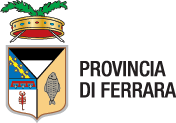Villas, historical residences and theatres
Ferrara
Palazzo Renata di Francia
The palazzo was built around 1475, possibly to a design by Pietro Benvenuto degli Ordini.
Palazzo Paradiso - Ariostea Library
The palace was built in 1391 and decorated with scenes of court life and motifs drawn from the literature of chivalry
Palazzo Turchi di Bagno
CLOSED UNTIL FURTHER NOTICE. Designed about 1492 by the architect Biagio Rossetti to create the so-called "Quadrivio degli Angeli" formed by palazzo dei Diamanti and palazzo Prosperi-Sacrati, this building is part of the large-scale urban planning work carried out by Rossetti under the Addizione Erculea plan
Casa Minerbi - Dal Sale
A jewel of Ferrara’s historical heritage, the recently restored Casa Minerbi – Dal Sale is an architectural complex which stands because of the fascinating dialogue between ancient and modern, immediately perceptible in the internal areas where fourteenth century pictorial cycles can be admired connected to contemporary spatiality created between 1957 and 1963 by architect Piero Bottoni from Milan.
Teatro Comunale "Claudio Abbado"
Dedicated to the great conductor, Claudio Abbado, the theatre was built between 1790 and 1797, under the direction of the architects Antonio Foschini and Cosimo Morelli
Casa Romei
Giovanni Romei became administrator to the lords of Ferrara and married the princess Polissena d’Este. On the Via di San Francesco he had a house built that showed his high ranking.
Palazzo Bonacossi
Palazzo Bonacossi reopens on April 7th, 2022 with a new exhibition
Palazzo Costabili
In 1502 work began on the construction of a large palace on the Via della Ghiara (now Via XX Settembre) for Antonio Costabili, Ferrara’s ambassador at the court of Ludovico il Moro, the Duke of Milan
Palazzo dei Diamanti
The magnificent Palazzo dei Diamanti, at the centre of the Addizione Erculea, on the important crossroads known as the Quadrivio degli Angeli, belonged to the duke’s brother Sigismondo d’Este.
Palazzo Municipale
Begun in 1245, the City Hall was the residence of the Este family until the 16th century. The main entrance is through Volto del Cavallo, opposite the cathedral, and is flanked by two sculptures, copies of the original 15th century ones.
Palazzo Schifanoia
Extraordinary vestige of the splendour of the Renaissance period, Palazzo Schifanoia is the symbol of Este Ferrara. New itinerary is open to visitors (divided over 1400 square meters, 21 rooms, about 250 works of art), new layout, new lights and new museographic concept, developed with the aim of reconnecting Ferrara with one of the most important testimonies of its history
Palazzina Marfisa d'Este
TEMPORARILY CLOSED. The Villa is a splendid example of a 16th-century high-class residence and was once surrounded by magnificent gardens that connected it to other buildings known as Casini di San Silvestro.
House of Ludovico Ariosto
The house, probably built to the design of Girolamo da Carpi, has a simple but elegant brick façade
Argenta
Delizia Estense di Benvignante
This work by the court architect, Pietro Benvenuto degli Ordini, was carried out for Borso d'Este and is an excellent example of the refined, elegant Ferrarese style during the Renaissance period.
Bondeno
Casa Ariosto
In and around the atmospheric village square there are various buildings worthy of mention, including the Casa Ariosto,...
Cento
Governor's palace
The Governor's palace, also called Palace of Justice or Palace of the Clock, was built in 1502 and looks onto the square named after Il Guercino.
Municipal Theatre
The Theatre was built between 1856 and 1861 and was projected by A. Giordani from Cento.
Codigoro
Bishop’s Palace
The Riviera Cavallotti, the street in downtown Codigoro overlooking the Po di Volano, offers a stupendous view of the river.
Comacchio
Palazzo Bellini
This building stands opposite the former Hospital of San Camillo, not far from the Ponte degli Sbirri.
Ancient Hospital for the Infirm
The stately old Hospital for the Sick can be found in Via Agatopisto, the pen name of the Arcadian poet Appiano Buonafede (1716- 1793).






